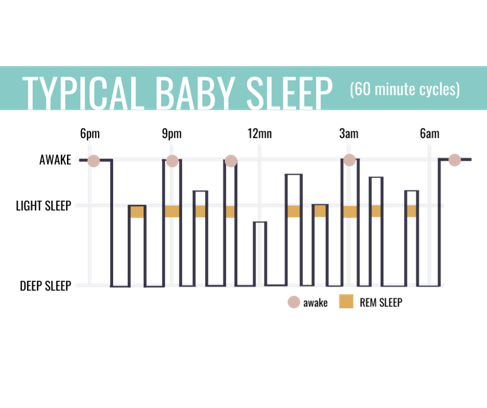Does Your Baby Cat Nap? Here’s What You Can Do About It

My third baby was a huge cat napper. He would fall asleep easily, but 20-30 minutes later, would be wide awake again.
I remember how stressful it was! Was my baby getting enough sleep? Why wouldn’t he sleep longer? Am I doing something wrong?
So let’s talk about it!
What Is Cat Napping?
Cat napping is when a baby will only sleep at naps for a short period of time, usually 30-40 minutes or less.
Why is this an issue?
Well, then thing is…it might not be! While we have a lot of research that shows the average number of naps and length for babies by age, that just shows the average.
In truth, research around how much sleep a baby needs at nap time and how long naps should be is slim, and what research we do have shows that there is a very wide range of how much sleep babies actually need.
And since every baby is different, we know that some babies grow and thrive while taking shorter naps!
For other babies, cat naps can be a problem if they really aren’t getting enough sleep.
Why can cat napping be a problem?
To understand why cat napping can be a problem for some babies, we need to take a closer look at your baby’s sleep cycle.
A baby’s sleep cycle is different than an adults. Babies have not developed a mature circadian rhythm, their sleep cycles are spread out throughout the day and night, and they have a different sleep pattern than adults do.
While adults have sleep cycles that last closer to 90 minutes, a baby’s sleep cycle is closer to 40 minutes, depending on the baby.
And while adults spend more time in quiet sleep, babies spend most of their sleep time in active sleep.


Typically, a baby will start their sleep cycle in active sleep, or REM sleep. This is when you might see your baby startle, twitch their limbs, etc. They can be easily woken at this stage of sleep, and they spend on average 20 minutes in this REM cycle.
This REM stage, or active sleep stage, is important for brain growth and development.
Babies then typically switch over to NREM sleep stage, or the quiet sleep stage. Babies in this stage of their sleepy cycle will be harder to wake up. Their body relaxes and heart rate slows. This is considered the restorative stage of the sleep cycle.
If you have a baby that consistently wakes up after their active sleep state, before completing their quiet sleep state, it can cause them to wake up before they feel fully rested, leading to fussiness and irritability. Research does tell us that in order to receive cognitive benefits from naps, the naps should be at least 30 minutes long.
And if your baby is not getting enough sleep because of their cat naps, it can interfere with their development.
How Can I Tell If My Baby’s Cat Naps Are A Problem?
For some babies, cat naps are not a problem and they get enough sleep and thrive.
For other babies, cat naps can cause them to get enough sleep.
Here are some signs that your baby may not be getting enough sleep:
- taking a long time to fall asleep
- frequent waking in the night
- early rising
- fussiness and irritability
- lack of interest in people and the environment
- yawning
- hand to face gestures (for example, rubbing their eyes)
- waking from naps in a groggy, irritable state
Be assured that according to the research we do have, sleep deprivation in infants is very rare. Even when taking short naps of 30-40 minutes, many babies thrive and grow because they still get the cognitive benefits of napping for at least 30 minutes.
What Can I Do To Get My Baby to Sleep Longer?
Remember, cat napping in most cases is not a sleep problem that needs to be “fixed”. Although we have some research on how much sleep babies need on average, research also shows that every baby is different and the amount of sleep they need can vary greatly.
If you are feeling like cat naps are impacting your baby in a negative way, or just isn’t fitting your life, there are a few things you can try to see if it will help baby nap longer.
Cat naps often occur when babies have trouble transitioning from one sleep cycle to the next. Once they go through their first cycle, they wake up and have trouble falling back asleep to go through another sleep cycle.
Here are things you can try to help your baby transition into their next sleep cycle smoothly and get them to nap longer:
- pay attention to how long the nap lasts until your baby wakes up. Once you have an idea of when they are going to wake, set a timer for 5-10 minutes before that point. When your timer goes off, carefully listen and observe your baby for signs that they are starting to wake up. Once they show the early signs of waking, quickly help them transition back to sleep using feeding, rocking, patting, shushing, etc.
- make sure you are following your baby sleepy cues and not trying to put them down for a nap too early or too late
- check the sleep environment – is the lighting too bright? what’s the temperature?
- try contact napping – many cat nappers will sleep much better and longer when sleeping on a parent or while being worn in a carrier around the house.

You don’t have to try all these strategies at once! In fact, it’s best to try 1 or 2 for a while before deciding whether it works or night. Remember, your baby’s sleep patterns will rarely change overnight – any time you are trying to gently shape your baby’s sleep, expect it to take some time.
Do you have a cat napper? Comment to share your story!
Need support? Book a sleep consult!
